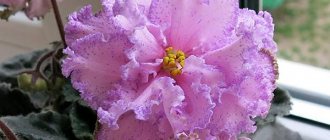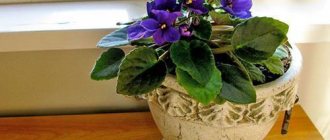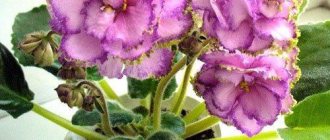The richest flow of colors and model configurations of Saintpaulia varieties registered by foreign breeding masters would be incomplete without retro varieties, which include violets Ruffled Skies and Ruffled Skies 2 (K.Stork/G.Boone).
Thanks to the time-tested sophistication of flowering and the pompous majesty of the images, as well as because of their self-sufficiency during development, both violets can still arouse the genuine interest of gardeners and are worthy of taking the best places on the shelves of collections.
Description of the variety
The variety is characterized by simple white stars with red fingers running from the center to the periphery.
The rosette is variegated, white and green, of standard size (diameter 24-26 cm). With age, the variegation becomes brighter. The flowers of the Carousel violet are completely red when they open. As it blooms, unpainted areas appear.
When the plant is kept in a cool room, the flowers will have a predominant white tint, and when kept in a warm room, the color will be red. At first after the bud opens, the red hue is very bright and saturated. However, it gradually fades and becomes paler.
The peduncles of violet Carousel are erect, bouquet type. Each of them has two or three buds. One flower blooms for about two weeks.
Violet Buckeye Sorcerer
Description
Saintpaulia with its medium-sized leaf rosette is described as a standard type. The bush fully corresponds to the varietal characteristics:
- smooth contours;
- symmetrical configuration;
- dense fullness;
- mosaic tiered arrangement of leaves.
The leaf blades have an oval-elongated shape, a pronounced central vein of a lighter shade, a smooth surface structure and a pronounced variegated color: the main background color is dark green and the bordering stripe of strokes and spots of an intense beige shade.
With very abundant formation of buds, violets never bloom in a cap type, only in a wreath . Due to weak peduncles, the corollas fall on the leaves of the rosette during the blooming process.
The opening of the buds takes long periods of time, which increases the overall flowering period.
The variety is distinguished by the original shape of the corolla , in the dissolution phase it looks like a half-bell, and in the full opening phase it resembles a lotus flower.
The color of the corollas is presented in two tones: the petals, white with a slight lilac tint, have triangles at the edges of a richer shade of lilac. Sometimes a green edging appears along the edge of the petals .
No sports were found in this variety.
Features of maintenance and care
The variety is inconvenient for breeding by beginners , as it belongs to the group of violet whims :
- with the slightest changes in care regimens, it stops its development;
- in intense lighting, the leaves strive to hug the flowerpot;
- lack of light can lead to elongation of leaf petioles;
- Flowering in a wreath predominates, the buds lie on the leaves.
Due to so many maintenance problems, violets are rarely found in collections and are little known to flower growers . But with proper care, taking into account all the nuances, this is a completely show-worthy, delicate and pretty variety.
Reviews
Varvara. “My violet “Buckeye Sorcerer” has been growing beautifully for the fourth year now, I haven’t noticed any special problems. Saintpaulia formed the rosette herself, it turned out beautiful, completely smooth. It blooms for a long time, with delicate flowers that do not stand upright and fall on the leaves. But this is its only drawback."
Galina Antonovna. “The Buckeye Sorcerer variety is rare, they say it is very capricious. But I would like to try to tame him. I’m writing to your wishlist.”
Violet Carousel: variety care
Photos and names of varieties of indoor violets (part 2)
Violet Le Carousel: photo of the variety
Caring for the Carousel violet variety is not at all difficult, but it still requires compliance with certain rules. Let's talk about them sequentially.
How to water correctly
Experienced gardeners recommend the wick method for watering Carousel violets. In this case, the flowering will be lush, bright and long-lasting. To do this, you need to stock up on synthetic cord (cord thickness - 2 mm) and a container of water. The length of the cord is adjustable according to the height of the container. The operating diagram of this method is simple: the two ends of the cord connect the source of water (container) and the consumer (pot with violet). Pass the cord through the drainage hole in the pot and roll it into a ring. The other end of the cord should be placed in water through a hole made in the container (not the bottom).
The effectiveness of this method of watering is that the violet takes as much water as it needs. That is, she is not threatened by waterlogging, which means she will be safe from many problems associated with it.
About fertilizing
The violet variety Le Carousel is fed 2 times a month. During the period when the plant is actively developing, nitrogen fertilizers are applied, for example, Bona Forte. If your plant likes the wick method of watering, then you can feed it using the wick. To do this, the tip of the cord can be transferred from the water to a tray, where the fertilizer can be diluted.
During budding, it is worth adding potassium and phosphorus fertilizers, for example, 3 ml (per liter of water) of “Uniflor-bud”. From September they stop fertilizing the violet, allowing the plant to prepare for dormancy.
How to trim correctly
When they talk about pruning the Carousel violet, they mean regularly cutting off the leaves from the bottom row that are beginning to fade. It is better, of course, not to let the wilted leaves be found on the surface of the ground. In this case, various diseases may appear.
About the transplant
Carousel violets are transplanted in the spring, most often in early March, before the plant blooms. Since its roots gradually grow, replanting is required annually for rejuvenation.
If your violet bush is moistened using the wick method, then it needs light and loose soil. The soil mixture should consist of equal proportions of perlite, high peat, and vermiculite. A medium-diameter Carousel rosette is planted in a pot (possibly plastic) with a diameter of 0.1 m and a height of 0.1-0.12 m.
When repotting, tap the pot from different sides to help the earth ball release the pot. Carefully, when dumping the plant out of the pot, make sure that some soil remains on the roots. That is, shaking off the soil is not necessary, except for some diseases.
If you have the proposed soil composition for violets, then a drainage layer is optional. Pour some potting soil into the new pot, making a small mound, and place the plant there. Carefully add soil around the edges of the potting container.
Socket rejuvenation
The sockets are rejuvenated annually. In the photo, the Carousel violet looks beautiful. To get such a plant, you need to replant the violet annually, renewing it. To do this, remove the lower leaves. All wounds must be sprinkled with activated carbon. Then, using a sharp knife or blade, cut the roots of the plant at an angle of 45 degrees below the level of the bottom row of leaves. Then the rosette is planted in the ground and placed in a greenhouse. In about a month, new roots will grow, new leaves and flower stalks will begin to grow.
Uzambara violet.
Family Gesneriaceae - Gesneriaceae.
Genus Saintpaulia hybrida - Hybrid Saintpaulia.
African violet saintpaulia hybrid.
Violets from breeders of the CIS countries - “K” (LE-2).
LE- Carousel (E. Lebetskaya).
LE-Carousel (E. Lebetskaya).
Simple white stars with red fingers on the petals.
Variegated white-green foliage. Standard. The rosette is neat with beautiful variegated foliage; it becomes brighter with age. He forms the rosette himself. Socket diameter 26 cm.
At the beginning of flowering, the flowers open, all well painted, and then unpainted ones appear. When kept in cool conditions, there is more white on the flowers; when kept warm, the coloring is better. Where there is more red, it is still more beautiful. The red color is very bright, but the color fades over time. The flower stalks are erect and there are many buds on them. Peduncles stand in a bouquet. The number of flowers on the peduncle is not enough, three flowers per peduncle, some with two.
The flowers fall off, although they last quite a long time, about a couple of weeks. There are a lot of flowers, so even if they fall off, they are always replaced by others, fresh ones. If the violet stands on the wick and the soil is moist, then they do not fall off longer. They fall off as the flower ages.
The variety grows very quickly and begins to bloom early.
Very similar to LE-Margarita (E. Lebetskaya). But LE-Margarita has cup-shaped flowers, dark cherry prints are more clear, like stripes, and LE-Carousel has star flowers with red prints all over the petal. The leaves are also different; LE-Margarita's are dark, while LE-Carousel's are light green. Both fall off, but with LE-Margarita the flower lasts longer.
Do you know that…?
Caring for trailers is a little different than caring for rosette violets. First, trailers require a lot of water. Secondly, trailers eat a lot. They will have to be fed more often than usual. You need to be aware that trailers need a lot of nutrition and fertilize them so that the lower leaves do not age prematurely. And since the trailer forms long stems, which must be leafy along their entire length, the preservation of older leaves is very important. Therefore, it is very important to fully provide the trailer with water and food.
Relocating a trailer. The trailer also needs to be relocated. Maybe not as often as rosette violets, but it’s also necessary. It is better to do this when it is still young, then during transplantation you can adjust the direction of the trunks, deepen and rotate as necessary. It is very difficult to do such manipulations with a fully developed plant. This activity requires patience and accuracy. You need to pull the lump out of the pot, shake off the roots and, using improvised means and your fingers, push the roots and fresh soil into a larger pot.
A very important point - the beauty of trailers is not endless. They outgrow, lose their shape, and become coarse. Trailers with thin stems collapse from the slightest dryness, begin to droop, and the lower part of the trunk will inevitably lose leaves. Hanging stems can easily break off even under their own weight. Therefore, you need not to miss the peak of development and get maximum flowering during the maximum beauty of the bush.
Before you buy the violets listed below, carefully read the forums about their behavior on the windowsill. Many of them are very beautiful flowers. However, these can be large rosettes with large and fragile leaves, with leaves rising up or hugging the pot, forming many stepsons that interfere with the formation of a neat rosette, pulling the stem up and growing into a Christmas tree, bending the trunk, rare flowering with long breaks, fallen flowers or they last little and quickly wither, very long and recumbent peduncles, the color of the flower fades quickly, they do not like bright lighting on the windowsill, they are afraid of the slightest drying out or waterlogging, a large percentage of them go into sports or darken the flower.
Read also: Description of the cocktail grape variety
Are they suitable for your window sill and the conditions that you can create for them? You will look at the flowers for several months, and the rosette will always be in front of your eyes. There are many beautiful flowers, there are much fewer beautiful and neat rosettes, look first at the rosette! Search and you may find a dozen violets with the same flower color if you are not interested in the smallest details as a collector.
• — Cardinal (Lebetskaya); • — Karina (Lebetskaya); • — Katya (Lebetskaya); • — Kiev Meetings (Lebetskaya); • — Cobalt Rose (Lebetskaya); • — Wings of an Angel (Lebetskaya);
If violets could talk, they would certainly tell us about their most devoted fans. People who grow Saintpaulia with special tenderness and care, nurturing and nurturing their green pets from the first to the last leaf.
And the name of one of them was certainly among the first - breeder Elena Lebetskaya, who creates miracle after miracle with her own hands every year. Today we will talk about the best varieties of this grower. You can also watch a useful video on this topic.
Lighting
All about rose Novalis: description and photo, cultivation and care, nuances of transplantation and other features of the variety
Violet Carousel belongs to the heat- and light-loving varieties. In order for a plant to grow quickly and bloom profusely, it needs a lot of light. However, the plant does not like direct sunlight, but it likes diffused light.
It is better not to place plants on southern windows, as direct sunlight can cause burns. If there is no other place, then when placed on a south window, shading is necessary.
The ideal option is to grow violets in the kitchen: this room has high humidity and a lot of light. In the kitchen, Saintpaulias grow quickly and bloom profusely. If there is not enough light, the violets will stretch out and their rosette shape will be disrupted.
To successfully grow violets, it is recommended to place plants on northern windows in the summer. They feel quite comfortable on them, pleasing the eye with a beautiful rosette and abundant flowering. Conditions for growing at home
The manifestation of its varietal characteristics depends on the conditions in which the flower will be kept: variegation, duration and brightness of flowering.
Location and lighting
LE Carousel loves bright, diffused light, but is afraid of burns from direct rays of the sun. The best placement would be windows facing southwest and southeast. During short daylight hours, the plant needs to be provided with additional lighting with fluorescent lamps. In general, daylight hours should last 12–14 hours.
Temperature and humidity
The plant likes to be kept warm, the optimal indicators are +20...+23°C.
Important! When the recommended temperature increases, the red tone will predominate on the petals; when the recommended temperature decreases, white will predominate.
Violet Buckeye Love's Caress
Description
Based on the size of the leaf rosette, Saintpaulia is classified as a large standard type . Bushes of significant dimensions certainly have aligned contours, dense filling and an original pattern of leaf arrangement, formed according to a mosaic principle.
The leaf blades have an elongated-pointed configuration and are distinguished by an extruded venation graphic, a leathery surface structure, smooth or wavy-jagged edges and a dark green coloration with a more or less wide edged edging of stripes, strokes and spots of a cream color with pinkish tints.
The underside of the leaves has a reddish tint.
The violet blooms in bouquet type often and for long periods of time with the formation of a mass of large corollas of a simple or semi-double type on strong peduncles. The petals are characterized by abundant corrugation of the edges, which is more pronounced on the upper lobes of the flowers.
The buds are painted with transitions of lavender shades with a bright purple braid along the contour and the same fantasy touches across the entire surface. According to the varietal description, the formation of a greenish thin frill at the tips of the petals is possible.
Photo of Buckeye Love's Caress violet.
Violet variety "Buckeye Loves Caress" is prone to frequent sporting . Sports can manifest themselves in two varieties:
- with flowers of an even purple color with a slight salad border and without obvious speckles of fantasy;
- with leaves of a lighter color and original corollas with a soft lilac tone, modest fantasy strokes and stripes, wavy-notched contours of the lower petals and two small rounded upper petals with a green fringe.
Features of maintenance and care
Due to its positive qualities, violet is good for growing in the collections of experienced flower growers and novice hobbyists .
The variety independently forms a leaf rosette , does not require special care, develops well and blooms luxuriantly with a minimum set of classical maintenance regimes.
Saintpaulia is resistant to temperature fluctuations , but does not like sudden changes in temperature and drafts. It prefers placement on shelves under fluorescent lamps, where it blooms much more luxuriantly and more readily.
CAREFULLY! With additional lighting, violets should be placed at a sufficient distance from the lamps, otherwise the variegated decorativeness of the leaves may disappear due to the strong light intensity.
The variety gives the first flowering earlier , then the formation of buds occurs with enviable consistency and short rest intervals. Varietal characteristics appear more clearly from flowering to flowering.
Reviews
Tamara Andreevna. “I’ve been collecting a collection of varieties from the Bakai line for a very long time. One of my favorites is the violet “Buckeye Loves Caress” - it is not whimsical, it grows and blooms actively and beautifully, each flower can please me for more than a month. And its colors never get boring.”
Pyotr Selivanovich. “At the exhibition I liked the Saintpaulia variety “Buckeye Loves Caress”. My wife tried to dissuade me for a long time because she had heard about the instability of the variety. I didn’t listen, bought a piece of paper and got a light sport as a result. But I liked him no less. I’ll leave it with you.”
Temperature
All varieties of violets love a temperature of 20-23 degrees. In such conditions, the plant will grow quickly and delight with abundant flowering for a long time.
In order for the plant to develop and grow better, it needs to provide a slight temperature difference of 1-3 degrees between night and day temperatures.
For babies who have recently separated from the mother's leaf, a temperature of 23-25 degrees is recommended.
When grown, the plant easily tolerates temperatures down to ten degrees, but increases up to thirty are poorly tolerated. This is indicated by poor flowering, small flowers, and deformed rosettes.
Choosing a pot
As you can see in the photo, the Carousel violet is a standard species. It requires small pots, no more than 10-12 cm in diameter. Violets have a root system that is compact, taking up little space in the pot. Therefore, there is no need to purchase large pots for them. In them the plant will grow for a long time and will not bloom soon.
Too small pots with a diameter of 5-6 cm are ideal for growing baby violets, but adult plants will be cramped in them and will not be able to develop normally in such mini-containers.
Ideally, when choosing a pot, it is recommended to use the following formula: the diameter of the pot should be three times smaller than the size of the rosette. The carousel is about 25 cm in diameter, which means the pot for it is about 8-10 cm.
What popular types are there?
You can find approximately 15 varieties of cyclamen (Cyclamen L.), including:
Cyclamen Persian care
Persian
This is a plant variety that originated in the Eastern Mediterranean. The leaves are heart-shaped and painted in a rich emerald green color, which is diluted with a marble pattern.
The flowers are located on long shoots and in their shape are somewhat reminiscent of butterfly wings. There are flowers in both white and red shades.
You can enjoy the bright flowers for many days. From October to March, cyclamen produces about 100 flowers that will delight you with their aroma. From May to June the bush is dormant.
European cyclamen
Or, as it is also called, alpine violet, can be found in its natural environment in Central and Southern Europe. The plant has smaller leaves compared to the previous species. Depending on what color the cyclamen flowers are will determine what aroma it will emit. Unlike all other varieties, this one does not shed its foliage during hibernation.
Kossky
First discovered on the island of Kos, it differs from other varieties in its petals, which taper towards the base and are endowed with darkening spots.
Ivy or Neapolitan
The plant variety has leaves that differ from other brethren with notched-toothed edges, which have a lot of similarities with the famous ivy. Flowering begins in September or early November. Flowers form much faster than the leaves of the bush.
Caucasian
Caucasian
In the Caucasian variety, which grows in this area in open ground, foliage appears in the fall and exists under a layer of snow all winter.
The leaves can be either round and heart-shaped, narrow or elongated. The color varies from dark green to brown shades. Miniature flowers, the circumference of which does not exceed 2 cm, are painted in shades of pink with dark lilac spots at the base. The brown tuber forms roots from the bottom.
For growing cyclamen in rooms, mainly the Persian species is used, which includes many varieties and varieties.
You can find standard ones with flower stalks reaching 20-30 cm, medium-sized ones with shoots from 15 to 22 cm, and low plants with shoots with flowers no more than 15 cm.
The most popular varieties:
- Charlie
- Laura
- Scarlet Moth
- Vanessa
- Delight terry white, pink, lilac
- spring moth
- Fringed Red Delight
- Lilu salmon
- Rose
- Flamingo
- Aneli
- Sylphide
- Topaz
- Gait
- Rembrandt
- Fantasy
- Elf
- Super Verano
- Bellissima
Any of these names can often be found in an ordinary apartment or office space on the windowsill. After all, cyclamen mix was often presented as a pleasant present or token of attention.
Reproduction
Violet LE-Carousel is easily propagated by leaves and cuttings, peduncles. There are several ways to re-root a plant: put a leaf or cutting in water, or immediately plant the material in the ground. In the latter case, it is necessary to place the container with the plant in the greenhouse.
Reproduction by peduncles is applied to chimeras. Other varieties are rarely propagated by this method.
Violets are most often propagated by leaves. To do this, take a healthy leaf from the second row from the bottom. The petiole is cut at an angle of 45 degrees. The length should be no more than three centimeters. The prepared leaf can be placed in water by adding an activated carbon tablet (prevents rotting).
After two to four weeks, roots form on the leaf. As soon as they reach a centimeter in length, they are planted in the ground to a depth of no more than one and a half centimeters and covered with a bag. About a month later the babies appear. As soon as they have two true leaves, they are placed in separate containers. It is better to use disposable cups for this, with a volume of no more than 100 grams.
What should the soil and pot be like?
The Buckeye Seductress violet prefers loose soil that allows air and water to pass through. The best soil mixture for this variety is one intended specifically for violets. However, if it is not possible to purchase such soil, it is permissible to use ordinary disinfected garden soil with humus for this flower. When using such soil, you first need to put expanded clay on the bottom of the pot, and then several pieces of charcoal. Before backfilling, garden soil should be sifted (preferably twice). Disinfection is carried out by steaming.
Buckeye Seductress is a violet (a photo of this beauty can be seen on the page) that prefers not too large pots. A flower bowl with a diameter of 15 cm and a height of 10 cm will be quite enough for an adult plant.
Garden violet ivy
Synonyms. Violet ivy; reniform violet (V. reniforme).
Growing conditions. The plant is thermophilic, does not tolerate frost and does not overwinter in temperate climates. Loves damp, marshy places. In the summer, the plants are taken out into the garden and placed in a cool, bright room for the winter, reducing or temporarily stopping watering and fertilizing. Propagated by dividing clumps in the spring.
Garden ivy violet is cultivated as a container ground cover or carpet plant, most often together with other tall ornamental crops. Prefers partial shade.
Briefly about the breeder Elena Lebetskaya
Attention: The author’s passion can be seen from afar - her garden plot and house are buried in flowers. Most of them are violets
Simple collecting gradually grew into a lifelong pursuit, and now there are more than 400 varieties bred by her hands.
All her “brainchildren” are extremely popular not only in Ukraine and Russia, but also in neighboring countries. The only variety in the world, Leons Yarly Spring, with huge snow-white stars, was bred by her and received a prize at the first All-Ukrainian competition and the approval of the audience. Her violets have twice received the title of “best violets of Ukraine” - “Sultry Summer” and “Impresario”. Lebetskaya varieties are marked with the prefix LE.
Reviews about violet
Nina, Khabarovsk. “I was looking for this variety for a very long time, but the first flowering did not impress me. But the second time it bloomed exactly the way I wanted. Flowers that look like snowflakes."
Tatyana, Ryazan. “I spent a long time looking for information on the Internet about this variety and was in doubt: to plant or not to plant. But now, after flowering, I realized that I will never part with this variety. This mesh of blue wreaths is indescribable.”
Valentina, Russia. “I bought a small baby at the end of spring. She is growing quickly, there are no complaints. But in the end the rosette gave blue flowers. This is definitely not a variety, but I’m still pleased - the violet is very beautiful.”
Violet “whipped cream”: variety description, photo
Since time immemorial, houseplants have created coziness and a good mood. All people have different preferences, so each home has its own combination and variety of colors. But the favorite of almost all housewives, of course, remains the beautiful violet.
Among the latter you can find unique specimens - completely different in the shape of inflorescences, leaves or buds. Thus, the “whipped cream” violet can be called unusual. The photo given in the article clearly conveys the beauty of this flower.
Such a velvety flower will delight you for almost a whole year.
Description of the variety
A unique and attractive variety of “whipped cream” violets will attract the attention of even the most demanding gardeners. It is quite new, with large double inflorescences, and was bred by a Russian breeder - Elena Lebetskaya
The petals of this violet are wavy, together creating a feeling of foam. The effect is enhanced by crimson streaks and a thin corrugated border around the edges. We bring to your attention a photo of a “whipped cream” violet so that you can see all the charm of the described flower.
Its rosette is neat, the foliage is velvety, and medium-intensity green. The edges of the sheets are uneven, giving the impression of delicate whipped cream on a green plate.
Caring for violets
Violets are not capricious flowers. However, to make them happy, it is necessary to take proper care of them. The basic rules for caring for a “whipped cream” violet are as follows:
- providing the necessary sanctification;
- absence of direct sunlight and drafts;
- choosing the right flower pots and soil;
- regular moderate watering;
- timely transplantation and circumcision.
For violets, both proper consecration and temperature conditions are important. Air humidity plays an equally important role
The ideal temperature for whipped cream violet is 22 °C. Accordingly, at higher temperatures you need to increase the humidity. This can be achieved with special electrical appliances or improvised means. As an option, simply move the flower to the kitchen.
It’s good to give the violets a shower once a month. But this must be done carefully - the ground should be covered with a film so that excess water does not interfere with the proper development of the flower and does not harm it.
Reproduction of the variety
If you have such terry beauty in your house, you want to increase its quantity. This is easy to achieve even for beginners. Propagation of the “whipped cream” violet is carried out as follows:
- cuttings;
- seeds;
- dividing sockets.
The simplest method of propagation is by dividing rosettes. If another rosette has formed in one flower pot, it needs to be replanted as a full-fledged plant.
If your friends have spotted a charming “whipped cream” violet, you can borrow a leaf from the plant. It needs to be cut from the middle of the flower to keep it young. The petiole should be as long as possible. If rot appears, you can prune it. It is better to make the cut at a slight angle.
To begin with, the cuttings are rooted. The most common method is using water to which you can add activated carbon. You need to make sure that the container is filled with water at all times.
Propagation by seeds is a rather labor-intensive and time-consuming task. Not everyone succeeds the first time. Therefore, of course, the first two methods are preferable.
Transplanting and choosing a pot
At first glance, choosing a pot and replanting a flower is a simple matter. But if you do something wrong, you can lose your favorite plant.
Violets do not like excess freedom, so the pot must be selected according to the plant. Otherwise, the root system will develop strongly, which will lead to a lack of flowering. Experienced flower growers adhere to the rule - the diameter of the pot should be 3 times smaller than the rosette.
Most recommend repotting annually. And spring is the ideal time to replant flower crops.
The choice of soil also needs to be approached with caution. There are special earthen mixtures for violets
They are ideal for replanting plants. These are peat or compost based substrates that have a loose structure and contain all the necessary minerals.
The “whipped cream” violet loves drainage, so be sure to place expanded clay or other similar material at the bottom of the pot.
Violet “Ruffled Skies 2”
Below you will find a photo and description of the violet Ruffled Skies 2, which is a sport from the violet “Ruffled Skies” and is not listed in the official registers either as an independent variety or as a sports specimen.
INTERESTING! The number “2” was introduced into the name by Russian flower growers to distinguish violets.
Description
Young bushes of sporting violets are self-sufficient varieties that easily, without additional support from the violet grower, create the structure of a problem-free curly rosette from the entire volume of growing leaves.
The bush is formed as a neat standard , not changing its optimal size too often. But the development of the variety is carried out very measuredly.
Large-format leaves of an oval-wavy model with a slightly glossy textured quilting of the top layer have a slightly shaggy, multidirectional serration of the outline and strong curling of the edges, which leads to some chaoticness of the leaf mass .
The color of the upper part of the leaf is distinguished by notes of dark grass, the color of the lower side has a spray of reddish-burgundy tint.
Varietal flowers of quite significant parameters are painted in colorful colors of bluish-blue with cornflower blue reflections; the reverse side of the petals of many bushes is distinguished by a whitish coating.
In violets, a special nuance of the “star” corollas is considered to be the incomprehensibly terry structure of their assembly and the decoration of the petals with a light venous pattern .
The petals at the same time stand out with wavy edges. Their rich volume is noticeably increased due to the abundant corrugation and edging braid of a greenish color of varying saturation.
Sports
The violet's ability to form sporting bushes has not been noticed .
Features of variety development
Flower growers, when keeping intricately blooming violets in their collections, do not complain about the behavior of specimens of the tropical plant, since they have excellent independence and do not create unpleasant surprises.
Violet Ruffled Skies-2 shows an absolute lack of pickiness , integrates into the room microclimate system without any nuances, and blooms vigorously with remarkably large flowers of original color and texture.
The only important drawback is the extremely slow development of the bushes.
Saintpaulia can be propagated only by vegetative methods.
Bloom
The buds of the variety are supported by strong peduncles of a slightly large size.
The described variation of Saintpaulia does not immediately show the majestic forms of flower caps.
CAREFULLY! In hot microclimates, the green edge of the petals greatly reduces their volume.
Flowers of the variable variety remain in their original state for about a month and a half.
Reviews
Milana. "Showy, large-flowered specimens of Saintpaulia 'Ruffled Skies-2' give the impression of rich Venetian carnival costumes."
Reproduction of violets at home: methods of reproduction
There are 4 main ways of propagating Saintpaulia violets, with the help of which amateurs replenish and renew their collections:
- Leaf (or cuttings)
- Stepchildren
- Children
- Seeds
Propagation of violets by leaves (cuttings)
In the spring, during the active growing season, a middle-aged violet leaf with a petiole length of 2.5-5 cm is cut from the second row of the rosette. The violet cuttings can be rooted in water or in the ground.
To root a violet leaf in water, a cut of the cutting is immersed in water to a depth of no more than 1 centimeter. This level must be maintained throughout the entire rooting period. To prevent the occurrence of pathogenic microflora in the water, it is recommended to add half a tablet of activated carbon to it. When the roots appear, you should plant the violet cuttings in a small container with good drainage and light soil. The seedling must be watered regularly, preventing the substrate from drying out. After 20-35 days, violet babies appear and are ready for planting in pots.
To root a violet leaf in the ground, the cut cuttings are immediately planted in a prepared container, which is covered with a plastic bag with holes made in it. This is done to remove condensation from the mini-greenhouse. The violet seedling must first be watered with a small amount of settled water.
Reproduction of violets by stepsons
The violet's stepson (daughter rosette) is a small process that appears in the axil of the leaf. Stepchildren spoil the appearance of plants, so they need to be removed. To separate the stepsons from the violet, you need to pinch their growth point and wait until 4-5 leaves appear
Next, you need to carefully cut out and root the stepson of the violet in a container covered with film. When several stepsons are formed, one of them is left on the plant, while the others are grown and planted in a new container
Reproduction of violets by children
The violet baby is an independent small plant with its own root system. Children of the Uzambara violet begin to hatch at the site of the rooted cuttings after 2.5-3 weeks. There can be several of them at once - it depends on how strong the cutting was chosen for planting. The best option for further transplantation of the baby is to wait until it acquires two or three pairs of leaves and gains strength. After this, you can separate the violet baby from the mother leaf and plant it in the ground.
There are two ways to separate the violet baby.
In the first option, the Saintpaulia leaf with its offspring is carefully removed from the pot, the soil is carefully removed from it, and the children are separated from the cuttings and from each other. It's better to do it by hand. The second method is “closed”: with this method, the cuttings are not removed from the pot, and the violet children are separated from the group as they grow up
The largest baby, on which the roots have already fully formed, is cut off with a blade or a sharp knife and planted in a pot with a special substrate for Saintpaulia. The latter principle of planting is considered more convenient, since several more generations of children can be obtained from an uninjured maternal cutting.
Propagation of violets by seeds. How to grow violets from seeds?
Professional breeders prefer to collect violet seeds themselves, while amateurs purchase them in specialized stores. To grow Uzambara violet from seeds, use containers no more than 5 cm deep filled with loose substrate. Its thickness should be 1-1.5 cm less than the depth of the container. Homemade violet seeds should be planted in pre-moistened soil, evenly distributing them over the surface of the soil. After sowing is completed, the container is covered on top with glass and white paper to achieve a uniform temperature inside the container. The optimal temperature ranges from 17°C at night to 21°C during the day. To ensure the necessary microclimate, the container with Saintpaulia violet seeds must be ventilated periodically
In the first days this should be done carefully. After 15-20 days, the seedlings have their first true leaves, and they are planted in large containers
Violet transplantation is carried out with great care, because the root system of the seedlings is weak and thread-like. After picking, they are again covered with glass and grown to a size that allows them to be planted for individual cultivation.
Reminder for a newbie!
Uzambara (Uzumbar) violet is a plant of the Gesneriaceae family, growing in the natural environment of tropical and subtropical regions of Asia, Africa, Eastern Australia, South America and the Indian Ocean islands.
Saintpaulia is a plant named after the Saint-Paul father and son, who brought a plant unknown to Europeans from the Uzambara district (modern Tanzania) in the 19th century, presented for the first time at the international flower exhibition in Ghent in 1893.
Indoor violet has been one of the most popular plants in indoor floriculture since 1927. By 1949, more than 100 varieties had been bred, and today their number exceeds several thousand.
Rooting
- possibly in water, in substrate, moss.
Priming
- purchased soil or a mixture of leaf, coniferous, turf and peat soil in a ratio of 3:1:2:1 with the addition of raising agents (perlite, vermiculite, river sand, crushed sphagnum moss.
Lighting - it is best to place flower pots on western or eastern windows. To ensure that the plant is evenly illuminated from all sides, the pots are periodically rotated. In winter, when daylight hours decrease, you can use artificial lighting - fluorescent lamps.
Caring is a real art and serious painstaking work at the same time, including watering, fertilizing, and creating a favorable humid climate. Water Saintpaulias as the soil dries. The soil must be moistened regularly, but excess moisture should not stagnate in the roots. When watering, you must ensure that water does not get on the leaves. You cannot water the Uzambara violet with cold water. Fertilizing is done with complex mineral fertilizer once every two weeks. Saintpaulia reacts negatively to a lack of nitrogen in the soil. Optimal air humidity is approximately 50%, temperature is 20-22 ° C, without sudden fluctuations and drafts. The leaves of the plant should not touch the window glass. Removal of faded flowers and damaged leaves is carried out regularly.
Reproduction - planting a leaf cutting, part of a leaf, or a daughter rosette. The most popular method is rooting leaf cuttings. The formation of roots and the development of children lasts 4-8 weeks.
Pests are one of the gardener's problems. There are many different types of pests and it is very difficult to classify them. Among Saintpaulia pests, several groups can be distinguished: mites (spider mites, flat mites, transparent mites, etc.), insects (aphids, thrips, springtails, poduras, scale insects, whiteflies, scale insects, etc.), worms (nematodes).
Diseases - distinguish between infectious (gray rot, powdery mildew) and non-infectious diseases (rotting of the stem and root, wilting of the lower leaves, yellowing, leaf spotting, incomplete opening and premature drying, falling of flowers) of plants. The causative agents of infectious diseases are bacteria, fungi, and viruses. To prevent infectious diseases, you should strictly observe the regimes of watering, temperature, humidity, and lighting. Non-communicable diseases usually arise due to poor agricultural practices. They may appear in one instance and not spread to others.
Violet Buckeye Eureka
Description
The violet rosette is formed according to the standard type. The bush invariably has a leveled configuration, dense filling according to the tiled principle of building tiers.
The leaf blades are distinguished by a rounded shape, a clear venation pattern with an emerald central vein, a glossy surface and a tone of summer greenery with a cream edging of varying widths.
The violet blooms with large-diameter stars of single or semi-double filling with a wavy contour of the petals, tints of a dim lilac-pinkish palette, a whitish back side of the flowers and bright, fancy specks and strokes over the entire surface, often uniting into solid purple stripes.
NOTABLE! The variety "Buckeye Eureka" can sometimes form sports with simple corolla stars of an even, purple hue and without fancy patterns. The changes do not affect sheet plates.
Features of maintenance and care
Violet can be easily kept in indoor collections by both experienced gardeners and novice hobbyists :
- does not require special care methods;
- is formed independently;
- It does not bloom in bouquets very often, but it is lush and beautiful.
The main advice is to follow the care regimens prescribed for variegated varieties . This means controlling light, providing cool conditions, and feeding nitrogen only in small doses.
Reviews
Ilya Andreevich. “The Buckeye Eureka violet has been in my collection for a long time. When it is propagated by leaf cuttings, among several children blooming according to the variety, a sporty one without fantasy and a darker color will certainly slip through. It looks nice, and there are always homes for it.”
Svetlana. “I am crazy about the Buckeye Eureka violet: in my opinion, this is the most gorgeous Saintpaulia of all the Buckeyes. I advise everyone to try growing it.”
About the difficulties of growing
Violet Carousel: video about the variety
If you properly care for the Carousel violet variety, attacks by insect pests and diseases are practically excluded. But still, anything is possible. We will introduce you to the main diseases, pests of the Carousel violet variety and ways to combat them.
- Fusarium is combated by spraying with “Fitosporin_M” in a ratio of 1.5 grams per 1 liter of water.
- Mosaic foliage is treated with Vitaros in a ratio of 2 ml per 1 liter of water.
- The whitefly is washed off with a soap solution.
In general, the Carousel violet variety is characterized by strong immunity against diseases and harmful insects, so it will not bring much trouble. And if you follow the rules of watering and fertilizing, then the Carousel violet will delight you for a long time with its lush flowering and bright variegated foliage.
Violet Carousel: growing a variety
The correct conditions for keeping the Le Carousel violet variety will guarantee variegation, duration and brightness of flowering, that is, its characteristic features.
About location and lighting
Violet Carousel will be responsive to the presence of bright and diffused light, but direct sunlight is contraindicated for it. It is best to place it on a southwest or southeast window sill. When there is little daylight, you cannot do without additional lighting. In this case, you can use fluorescent lamps. The overall average day length for this plant should be between 12 and 14 hours.
About temperature conditions and air humidity indicators
The temperature regime for the Carousel should be between 20 and 23 degrees.
Humidity for the Le Carousel filka variety should be moderate - within 55 percent.
This plant does not tolerate drafts and temperature changes, so when ventilating, be careful with this violet and protect it.
If the air is dry, you can increase the humidity using a tray with sphagnum moss, which must be constantly moistened.
Violet Carousel: variety description and characteristics
Violet Le Carousel: photo of the variety
Indoor violet can form rosettes up to 0.3 m in height. The violet variety Carousel is no exception. It is also distinguished by its dark green leaves with a thin white border and a wavy edge of the leaf blade. The leaves are slightly pubescent and raised upward, and often their surface has a glossy sheen.
Violet was often used by famous artists in their works (Alexandre Benois, Jules Lefebvre, Georges Rouget, Alex Gray, etc.). The poetic works of Pushkin, Shakespeare, Pasternak, Fet and many other brilliant writers also did not avoid this plant in their poetic works.
At the beginning of spring, the Le-Carousel violet can already produce several buds on long erect peduncles. The petals of the plant have three shades - red, burgundy and fuchsia. As the petals form, the plant will delight you with the appearance of a wavy white edge, the same as that of the leaves. The shape of the flower resembles a five-petaled star. After a couple of weeks, the saturation and brightness of the petals disappears, they become duller. But they are replaced by new inflorescences. In total, the plant produces constant flowering for two months.
Violet Rosie Ruffles
The Rosie Ruffles violet, bred by D. Harrington, is a standard sized rosette consisting of pubescent green leaves with a wavy shape. The main advantage of the variety is its large star-shaped flowers. The color of the flowers is a light fuchsia shade. The edge is densely corrugated, lace.
Often gardeners are faced with the fact that children and rooted tops of rosettes do not retain the wavy edge of the petals inherent in the variety, and the decorative effect does not return as Saintpaulia grows. But when you place Rosie Ruffles violet plants on a cool windowsill, you can get a bright green border on the flowers.
Watering
It is recommended to water the plants as the top layer dries. You should not overdry the flower as well as overwater it. In the first case, the plant will dry out quickly, and in the latter, it will rot. However, when growing violets, it is better to underwater than overwater.
Plants must be watered with warm, settled water. Do not allow drops to fall into the center of the outlet.
Sometimes, plants are washed to remove dust from the leaves. This procedure is carried out approximately once a month. Each leaf is washed separately under running warm water. In this case, the pot should be tilted so that water does not accumulate in the center of the outlet and does not erode the soil. After a shower, Saintpaulias are dried in a warm place and only after drying are they returned to the windowsill. When growing on racks, the plants are immediately put in place.










